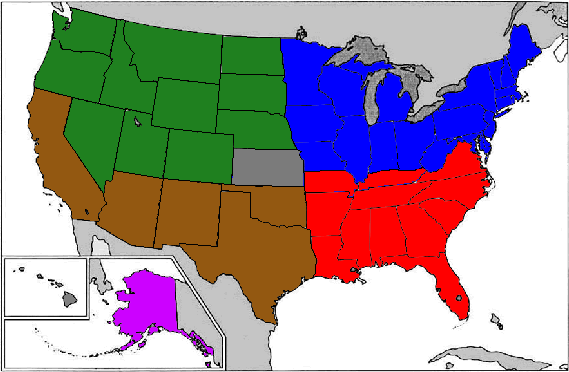
The former United States - ca. 1923
Legend
The Lone Star RepublicThe United States of America
The Confederate States of America
The Free American Republic
The People's Republic of Alyeuska
The Confederate Revolution
The Confederate States of America seceded from the United States in January 1861, sparking a bloody war. Throughout the first half of that year, more states, including Virginia and Arkansas, seceded and joined the CSA as well.
Then, fagtigued from three years of fighting, the Northwest Confederacy seceded from the USA in June 1864. This, combined with English and French recognition for the CSA, proved to be the deciding factor. Unable to fight a two-front war, the USA admitted defeat in September.
The Western American War
The peace was to last for less than two years. In February 1866, the Lone Star Republic declared its independence from the CSA. This declaration began a second war, lasting until May of 1867.
The Northwest Confederacy was slow to respond at first, but in April of 1866 finally launched an offensive, egged on with guns and training by the CSA. Unfortunately for the Confederacy, they failed to count on the involvement of the many indigenous people living in the Lone Star Republic. It was primarily due to these fighters that the LSR was able to successfully wage a war of attrition, ending with massive casualties for the Northwest. The self-governing Lone Star Indian Territories was established shortly thereafter in the former Oklahoma territory.
The Farite Revolution
Late in 1872, political essayist Michael Farrad was hanged for treason in the Northwest Confederacy after sharply criticizing the government for its failure to protect human rights in the states. The crowd at the hanging grew rowdy and proceeded to erupt into a full-scale riot, followed by a battle. This was followed by similar uprisings by angry citizens throughout the following year.
It was the work of Simon Sterne in August that catalyzed these uprisings into an actual organized revolt. Sterne traveled the country stirring up support. His group secretly set up its home base in the town of Kuna, Idaho. When the government found out, their troops pillaged and burned the town.
This proved to be their fatal mistake. This brutality galvanized Sterne's supporters and gained him popular sympathy. By February of 1874, the Free American Republic had declared victory.
Alyeuska
When gold was discovered in the Klondike in 1896, Canada's long-standing hopes to purchase the Alaska territory from Russia were effectively quashed. As discontented Farites and prospectors from all origins flooded north, the territory became one of the most populous Russian holdings.
As Russia's involvement in World War I dragged on, Alaskan citizens became increasingly discontent. In August 1917, the Russian Revolution began in Anchorage. This new home front forced Russia out of the war by November. Shortly thereafter, the People's Republic of Alyeuska announced its sovereignty.
The Labor Wars
Meanwhile, on May 6, 1909, in Waco, Texas, a group of farm workers employed by Amalgamated Farms went on strike. When the bosses brought in scabs the following day, fighting broke out in the fields. Unions quickly formed and battle lines started to be drawn. What began as skirmishes here and there gradually increased over the years into a full-scale war between dozens of parties.
With the entry of the Freemen, the trade associations, the International Workers of the World, and finally the Working Women, the stage was set for 1918 to be the bloodiest year yet in the Labor Wars, with 3,000 killed in battle.
1920 saw the formation of the Labor Party, an organized political force for labor interests in Congress. Their presidential candidate John Gomez was defeated in the 1921 election by the opposition Free Soil Party's candidate Andrew Smith. Smith had run on a platform of non-involvement in the Labor Wars. However, under pressure from business interest groups and their supporters in Congress, he signed the narrowly-passed Labor Regulation Act the following year. For this, his own vice president, Timothy Sparrow, challenged Smith to a duel and killed him.
By April 1923, the Labor Wars had been raging unabated for 14 years, with thousands of lives lost on both sides. Fearing the consequences if no action was taken, prominent politician Timothy Althaus organized a series of peace talks at his mansion. Could a last-ditch attempt at reconciliation save the Republic?
